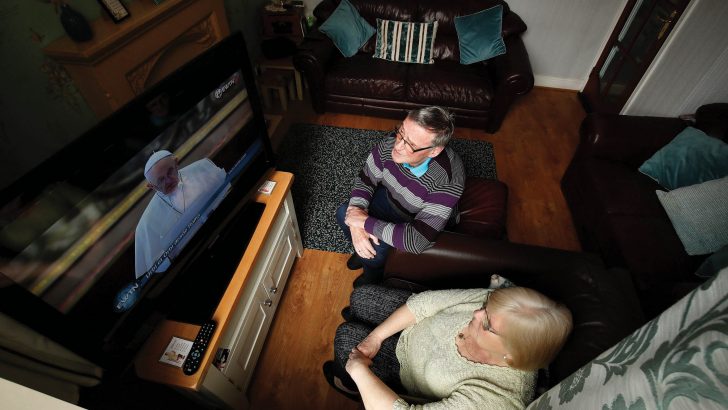The lockdown has caused huge damage and it’s simplistic to look at it only in terms of lives saved writes David Quinn
Public worship in Ireland is now due to return on June 29, not July 20, as originally planned. It’s still one of the latest dates in Europe even though our outbreak was not as severe as in countries such as France, Italy or Spain. It is a big, and sensible step in the right direction all the same.
Here in Ireland we spend too much time comparing ourselves with Britain and America, probably because they are English-speaking countries and our connection with them is so strong. We believe Covid-19 has caused carnage in both of those countries whereas we have managed things extremely well.
In fact, at the time of writing this article, Ireland had experienced 345 Covid-related deaths per million people compared with 337 in the US. In other words, the outbreak has been worse so far, although it hit America later than here. In Ireland, almost two-thirds of deaths were in care homes, where the situation was appalling.
In the US, New York was by far the worst hit city. Many other big cities in America have barely been hit by comparison.
The picture is worse in Britain where there have been 609 deaths per million at the time of writing. But the situation varies greatly by region. Northern Ireland, for example, has had roughly the same rate of death as the rest of Ireland. Population density has a lot to do with how badly a place will be hit.
For the record, other countries with small populations have done far better than Ireland. Austria has had 76 deaths per million. Denmark has had 101 deaths per million. Ireland has not done as well as either the Government or the media would have us believe.
Bigger countries like France, Italy and Spain have had, respectively, 434, 560 and 580 deaths per million that we know of. Those countries entered lockdown on March 17, March 9 and March 15 respectively. Ireland entered lockdown on March 28, although we went into semi-lockdown in mid-March.
When you went into lockdown is relevant to when you start coming out. It indicates when the virus in a given country became sufficiently bad to warrant the measure. We can see that Italy went into lockdown about three weeks before us, and France and Spain less than a fortnight before us.
Normality
But they have been returning to some semblance of normality well before us. We won’t be back to public Masses, with limits on numbers and various other safety measures, until 13 weeks after lockdown was imposed.
In Italy, the gap was 10 weeks, in France 11 weeks, and in Spain about 10 weeks. That isn’t much of a difference, but remember, July 20 was the original return date, much later than those countries.
The July 20 date became increasingly indefensible as time went on. It is why the Government has generally speeded up the easing out of lockdown for all sectors. The slowness of the original timetable was no longer justified in view of how low Covid-transmission has become in the general community and after looking at what other European countries are doing.
This is all a matter of proportionality. The lockdown was saving lives, but it has almost certainly cost lives as well. For example, an unknown number of people have delayed cancer treatment. People with chest pains and other life-threatening conditions were not seeing their GPs or going into hospital.
Many face financial ruin, especially in the hospitality sector. Increased poverty is always associated with decreased life expectancy.
Others were trapped in situations of domestic violence. We can expect to see an increase in divorce. Several hundred thousand students have suffered lost educational opportunities.
In other words, it is extremely simplistic to look at this only in terms of lives saved by the lockdown. The lockdown has caused huge damage as well.
Notably, the Association of Catholic Priests (how many priests attacked those of us who questioned the slow pace of restoring public worship. That includes this writer and this newspaper.
They attacked us for asking why Church leaders were not pressing for an earlier return, unlike practically every other sector in society. What they left out was the fact that everywhere else in Europe Church leaders were pressing for exactly that, and succeeding.
Masses
Was Pope Francis being heedless of the common good in supporting a return to public Masses in Italy on May 18? Were the French bishops being reckless in seeking a return on June 1, or the Austrian bishops on May 15? And so on.
In fact, outside perhaps of Britain, it is hard to think of any groups of priests apart from the ACP, and that included basically every hierarchy in Europe, who did not seek an earlier date than originally scheduled.
If you make 100% safety your goal, you would never return, and certainly you would have to cease public Masses again during every flu season which can kill hundreds of Irish people. Some probably pick up the flu at Mass.
Dr Tony Holohan told me at one of the press briefings that he knew of no cases of any customer acquiring Covid-19 as a result of shopping for food during the whole of the lockdown. This gives an indication of how small the risk is of becoming infected with Covid-19 at Mass, so long as numbers attending are limited and everyone socially distances and uses hand sanitiser before entering church.
A June 29 return date to Mass is proportionate. It strikes the right balance between safety and normal life. Kudos to all those who have made this possible, including the bishops who worked behind the scenes.


 David Quinn
David Quinn Online Masses were widely watched, but a poor substitute for gathering together. Photo: CNS
Online Masses were widely watched, but a poor substitute for gathering together. Photo: CNS 